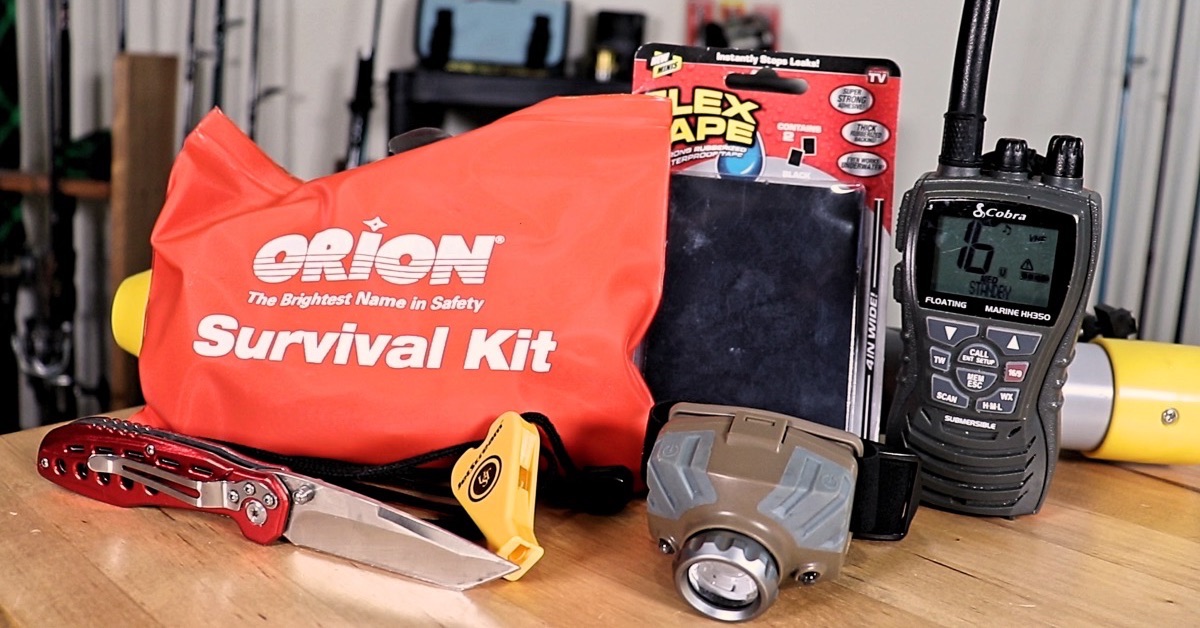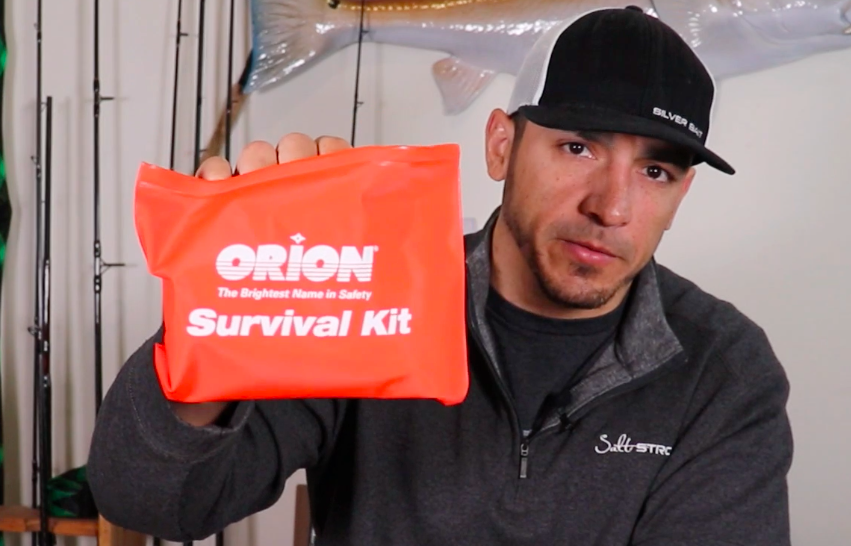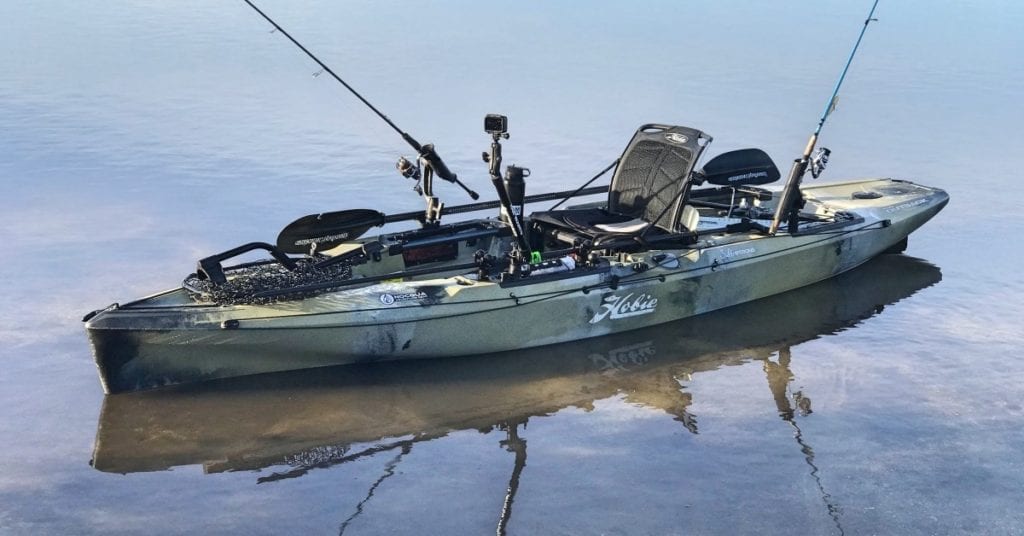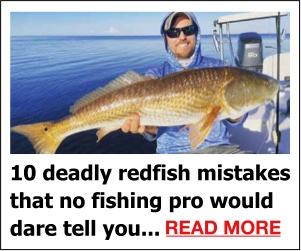8 Safety Items Every Kayaker Needs (That Fit In 1 Small Bag)
- By: Tony Acevedo
- on
- Found In: Fishing Tips, Kayak Fishing, Tackle & Gear, Weekly Newsletter: 2-21-21

Here’s something that doesn’t get talked about enough:
Safety equipment for your kayak.
Sure, it’s not cool like a shiny new reel, but these items could save your life (and give you many more years of kayak fishing).
So in this video, I’m sharing the eight items I always have with me on my kayak to keep me safe.
Some are things I like to have for my own peace of mind, while others are items that you’re legally required to have on board.
See what these items are and why you need them in the video below!
Kayak Safety Equipment [VIDEO]

Below are the eight items I always bring on my kayak.
You should also check your local laws to see what else is required to have onboard, as the laws are different in every state.
8 Kayak Safety Items
Life Jacket
Life jackets are required by law and could save your life if you go overboard.
There are two different life jackets I’ll have on board with me, depending on where I’m fishing.
If I’m fishing flats or lakes where it’s calm and I want to move freely, then I like to use an inflatable life jacket.
Some inflatable life jackets are manual, some are automatic, and some are both, but I prefer an automatic one.
And even within automatic life jackets, there are two different types:
- Pressure-activated
- Water-activated
I prefer the pressure-activated jackets, even though they cost a bit more, because you might splash the water-activated jackets in your kayak and accidentally activate them.
If I’m fishing in deeper, rough water, like off the beach or in an inlet, I prefer a standard foam life jacket, like the Magellan outdoors paddling life jacket.
Sound-Producing Device
Sound-producing devices, like a whistle or air horn, can help call attention to yourself if you get into trouble.
I prefer a whistle because it doesn’t expire or run out of air.
And I recommend keeping it attached to your body (around your neck or clipped to your belt or life jacket).
If you do happen to fall out and the current or wind takes your kayak away from you, you’ll want to have it on you.
Knife
A knife is another thing you want to keep on yourself (not just in a bag somewhere on your kayak).
On your kayak, you’ll have anchor line, fishing line, bungees, and other ropes around, and you really don’t want to get tangled in them if you accidentally flip.
In our recent kayak fishing podcast, Luke shared a story about having to rescue a guy who was stuck in the water for 20 minutes because his kayak flipped and his ankle was tied up in a rope.
It was November and he was freezing — don’t let that happen to you!
Always have a pocket knife or dive knife on you.
Headlamp
Even if you’re only planning on fishing during the day, you should still bring a headlamp.
The weather could turn bad, you could get stranded because of low tide, or you could find a school of fish and not want to leave.
All of these things are definitely possible and could cause you to stay out later than planned.
Headlamps can let you see what’s around you in the dark, as well as let other people see you.
Emergency Kit

Here’s what I have in my emergency kit:
- An Orion emergency kit
- First aid items
- Flex tape patches
The Orion emergency kit contains:
- An extra whistle
- A mirror to use the sun or your headlamp to signal where you are
- Signal flares
My first aid items include:
- Bandaids
- Patches
- Antibiotic cream
- Tylenol (or similar pain reliever)
The flex tape patches are surprisingly helpful for temporarily plugging a hole in your kayak in case something happens like you run over rocks or an oyster bed.
Manual Bilge Pump
If you get a hole in your kayak or accidentally leave a hatch open, you’ll be thankful you had a manual bilge pump on board.
Another option is to have a sponge to get the water out.
Waterproof Floating Radio
A radio can help you hear about weather updates and call for help if necessary.
Yes, we all carry cell phones, but you may end up out of range, the battery could die, you could drop it overboard…
Lots of things could go wrong if you’re solely relying on your cell phone.
I use the Cobra HH 350.
And here’s a tip: always be sure to keep the batteries for your phone and radio charged!
Anchor
I like having a small claw anchor on board to help hold me in place in case of an emergency.
If you cut or injure yourself, you’ll definitely want an anchor so you can stop moving and patch yourself up.
2 Kayak Safety Tips
The items above will help you be prepared in case of an emergency, but here are two other tips that can also keep you safe:
Tip #1: Tell someone about your plans
Let someone know where you’re going, when you plan to get back, and if someone else is going with you.
If you don’t get back at a reasonable time, they can try to contact you or the people you’re with, or start looking for you.
Tip #2: Write your information on your kayak
Write your name, address, phone number, and emergency contact on the hull of your kayak where it’ll be visible.
In case your kayak floats off or an accident happens and your kayak is found, authorities will know who they’re looking for.
You can go to the Coast Guard’s website here to get a sticker for this.
Conclusion

This might seem like a lot, but they’re all little things and they easily fit into a medium-sized dry bag.
You can keep everything stored in there so when you leave home to go kayaking, you can just grab the bag (but be sure your radio batteries are charged!).
Hopefully, you won’t need to use these items and tips, but if you do, you’ll be glad you were prepared!
Have any additional safety tips or equipment?
Let me know down in the comments.
And please TAG or SHARE this with your kayak friends so we can all be safe out on the water!
P.S. Want access to our best fishing spots and tips, plus discounts to our online tackle store? Click here to join us in the Insider Club!
Related articles:
- HOW TO SET UP YOUR KAYAK FOR INSHORE FISHING (TACKLE, TOOLS, & MORE)
- SALTWATER KAYAK FISHING (BEST KAYAKS, ACCESSORIES, & MORE)
- HOW TO FIND 90% OF ALL FEEDING FISH IN YOUR AREA (90/10 FISHING RULE)
Disclaimer: When you buy through links on our site, we sometimes earn affiliate commission from places like Amazon, Bass Pro, Tackle Warehouse, etc. It’s one more way we can help you quickly find the best deals on the web while making sure we’re still around to serve you for years to come (and you do want us to be around to help you catch fish for many more years, right)?
Related categories:
STOP WASTING TIME ON THE WATER!
Do what the “SMART ANGLERS” are doing and join the Insider Club.
Here’s what you’ll receive today when you join:
- Weekly fishing reports and TRENDS revealing exactly where you should fish ever trip
- Weekly “spot dissection” videos that walk you through all the best spots in your area
- Exclusive fishing tips from the PROS you can’t find anywhere else
- Everything you need to start catching fish more consistently (regardless if you fish out of a boat, kayak, or land).
STOP WASTING TIME ON THE WATER!
Do what the “SMART ANGLERS” are doing and join the Insider Club.
Here’s what you’ll receive today when you join:
- Weekly fishing reports and TRENDS revealing exactly where you should fish every trip
- Weekly “spot dissection” videos that walk you through all the best spots in your area
- Exclusive fishing tips from the PROS you can’t find anywhere else
- Everything you need to start catching fish more consistently (regardless if you fish out of a boat, kayak, or land).











You always have good stuff Tony. Thank you.
Thank you for the great feedback Donn!
Just starting to get into kayaking. Love the concise tips and list in this article. Thanks, Tony (and other commenters in the comment section)!
You’re welcome Eric! Thank you for the great feedback!
Thanks Tony! Very helpful info. Quick question – can you give me an example of a “pressure-activated” inflatable PFD? I asked Austin Kayak and they drew a blank. Thanks!
You’re welcome Richard!
You want to look for a pfd that has a hydrostatic auto inflation system. These are the types that inflate when submerged (pressure). Here is an example of one:
https://www.tacklewarehouse.com/Mustang_Elite_Inflatable_PFD/descpage-MEI.html?from=gshop&gclid=EAIaIQobChMIoYm_zbXl8AIVlQiICR3wCAv8EAQYAyABEgLioPD_BwE
Great info as always, Tony! I would recommend against putting your home address for POC information on the kayak as this provides disreputable people with information on where you live. I would leave it out or use something like your place of business if you would like to include this. For the phone number, I would also use something like a Google number that can be forwarded to your cell phone or house phone that doesn’t expose your home phone either. I usually provide a detailed float plan to at least two people with comms deadlines when I head out even in my boat. Florida Bay, 10K Islands and ENP backcountry are desolate enough to warrant a backup plan.
Thank you for the great feedback Luis! Yes just a name and phone number can get the job done.
A water jug that NEVER leaves the boat (maybe once a yr to replaces?) should also be on ones list?
I bring water with me on every trip. Definitely a must! You could also keep a Life Straw with you that filters water if you are really ever in a serious situation. Fits in your pocket!
Love this
Thank you for the great feedback Chris!
Hope I’m not posting twice…My Husband are thrilled to have joined your team. I actually caught a nice Sea Trout about 15″ and shortly thereafter FELL out of the boat. Long story…Had a heart attack getting back in the boat but made it and all is well. Can’t wait to fish again although I’ll be watching videos for three months first. When I came home from the hospital I saw your post about boating safely which was ironic as we had all the necessary equipment and I always wear my life jacket PERIOD! Thankfully we are safety conscious. The reason I fell out is because Hubby’s seat broke and he went in first throwing me off balance. We were only in two feet of water but the muck will suck you in, beware. I’m very much enjoying the daily post and can’t wait to get back out on the water. Thank you so much for all the great tips. Your new friend Bec
Oh wow, glad you guys are okay! I have fallen in the water numerous times (luckily the camera hasn’t been on during one of those mishaps…..yet).
I’m glad you are enjoying the site and club! Thank you so much for the great feedback!
Nice! As a lifetime boater and relatively new to kayaking, these are excellent tips. I’m in Jensen Beach and mostly Kayak around Lake Eden in the Savannas for bass and pan fish. This year I have ventured out to the Sailfish flats for flounder and pompano. Got a 25 inch flounder two days ago. Always learning! I saw a guy that used a couple of boat fenders like training wheels to help stabilize his kayak and I have some spare fenders from my big boats. I’m trying to figure it out without adding a ton of weight.
Thank you for the awesome feedback Stephen!
Yes I have seen guys make outriggers for their kayaks using those boat fenders. I’m sure there are plenty of youtube videos out there on making them (outriggers) for a kayak.
Great video as always. Another item I always carry is a Garmin inreach mini. It is a sat messenger. On the water, I always have a satellite signal. It also has an SOS button. Push the button and the cavalry comes. It is water resistant . I typically attach it to my PFD.
To add to Joe’s excellent comment…
I’ve had several inReach communicators over the years (including the O.G. one before Garmin bought DeLorme), and I currently own a GPSMAP 66i with inReach and routable mapping. During my various outdoor activities, there have been plenty of times that I’ve been “off the map” when it comes to cell service, but the Iridium satellite network covers 100% of the globe, so inReach offers great peace of mind.
When I’m doing something that might lead to a situation that prevents me from hitting that SOS button, I turn on tracking, so my position is being uploaded via Iridium to the inReach service every 10 minutes. That way, my wife and my sister (and the friends/relatives of others in the group, if it’s a group outing) will be able to see my position on the inReach website.
The downside is that inReach doesn’t transmit a 121.5 MHz signal, so a SAR team won’t be able to pinpoint me using a homing signal. They have to rely solely on the last GPS position successfully uplinked to Iridium.
Definitely another great item to have!
Pratical and informative!…good job Tony!
I keep a medium sized dry bag inside the hull of my kayak all the time (Tarpon 140 but not sure it will fit in my new Nucanoe Pursuit as easily though). In it, i keep firstaid kit, rain pancho, emergency blanket and a small survival kit. Before each fishing trip i check the items just to make sure they are in good working order.
Adding an identification tag to kayak is a GREAT idea that i will be looking to complete this weekend as long as this crazy TX weather breaks long enough.
I use a small soft tackle box for my fishing stuff but i also pack it with some safety items like blanket, whistle, mirror that would help in case i flipped my kayak and the current/wind took it. For this reason, my tackle box is about the only item that is not tied or strapped down on my kayak.
Great video content…keep them coming!
-Mark
Thank you for the great feedback Mark!